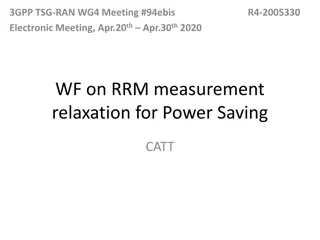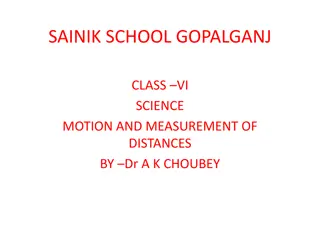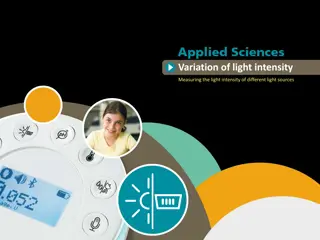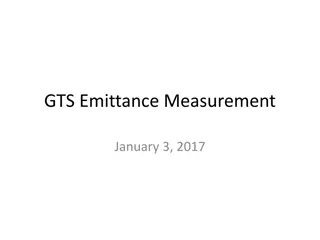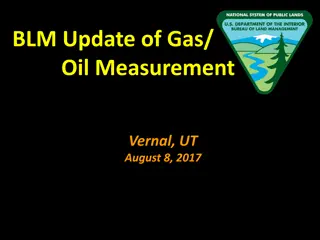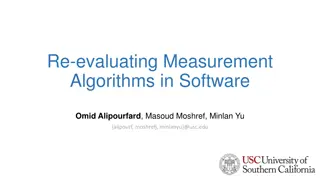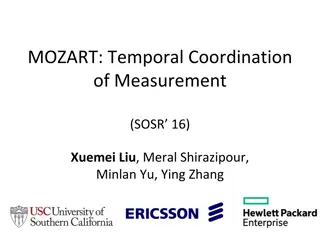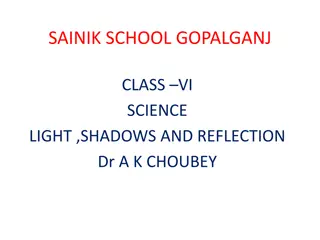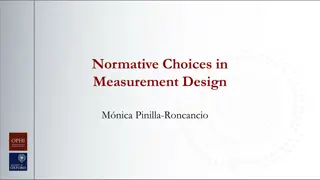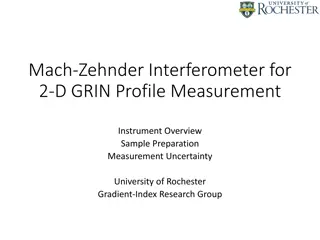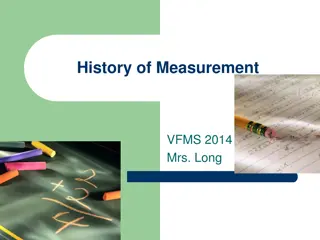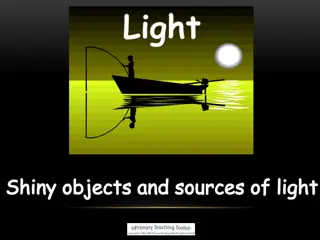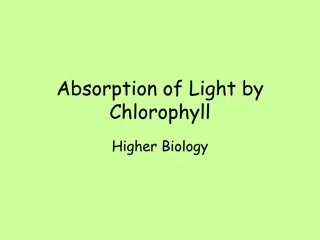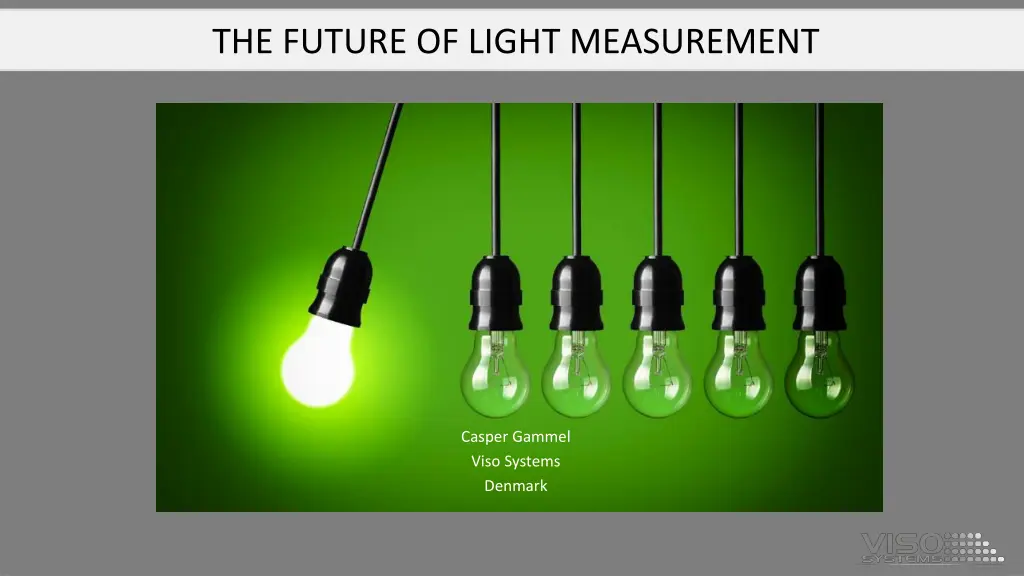
Understanding Light Measurement Techniques & Equipment
Explore the evolution of light measurement from early methods to modern integrating spheres and goniophotometers. Discover how integrating spheres and spectrometers enhance data collection, and learn about the pros and cons of these measurement tools for various lighting sources. Dive into the importance of angular distribution in the lighting industry and how goniophotometers provide essential photometric data.
Download Presentation

Please find below an Image/Link to download the presentation.
The content on the website is provided AS IS for your information and personal use only. It may not be sold, licensed, or shared on other websites without obtaining consent from the author. If you encounter any issues during the download, it is possible that the publisher has removed the file from their server.
You are allowed to download the files provided on this website for personal or commercial use, subject to the condition that they are used lawfully. All files are the property of their respective owners.
The content on the website is provided AS IS for your information and personal use only. It may not be sold, licensed, or shared on other websites without obtaining consent from the author.
E N D
Presentation Transcript
THE FUTURE OF LIGHT MEASUREMENT Casper Gammel Viso Systems Denmark
History of light measurement Photometry measures light radiation in terms of perceived brightness to the human eye. Main characteristic of light is luminous flux. Early days, eye estimation Late 1960 s, photometers and lux meters Mid 1850 s, Bunsen s photometer Around 1920 The first integrating sphere 1980 s first mirror Gonio photometers Angular distribution
Integrating spheres Main Equipment used today Luminous flux (lumen) coming from all directions of a light source - spherical shape integrates the light inside. Inside of the sphere is covered with a diffuse reflective surface.
Integrating spheres Adding a spectrometer to a integrating sphere gives more data Lumen Color temperature CRI Spectrometer
Measuring procedure of Integrating spheres Form calibration with out light source Form calibration with light source Primary calibration Measurement
Integrating spheres Results and further considerations Pros Good for measuring incandescent bulbs Cons - - - - Takes a long time for a single measurement. Directional lights give large errors (7-10%) Hot spot Linear lights needs huge spherical dimensions No 3D information (no IES/LDT files)
Goniophotometers The most used solution brings all the photometric data, IES and LDT files Goniometer: Angular distribution IES, LDT Integration sphere: lumen values + photometric data if using a spectrometer Angular distribution is of high importance for the lighting industry: manufacturers, designers and engineers need this information for 3D modelling.
Goniophotometers Typical systems include a photo-sensor + goniometer. Intensity in candela Angular distribution IES and LDT files Ang/C- plan 0 5 10 15 20 25 0 873,5683 873,5683 873,5683 873,5683 873,5683 873,5683 1 874,6646 874,6746 875,974 876,3697 877,5536 877,5846 2 875,7609 877,1144 878,3796 880,3233 881,5389 883,1025 3 876,9303 879,5541 880,8093 884,2769 885,5242 888,6204 4 880,013 881,9939 885,5896 888,2305 891,8943 894,1384 5 883,0957 886,28 890,3699 6 886,1784 891,314 895,1503 900,4158 905,3885 909,1572 7 889,9412 896,348 900,6319 906,7136 912,4092 917,0578 8 894,9252 901,3915 907,5309 913,1996 920,7552 924,9584 9 899,9092 906,9208 914,43 920,8501 929,1012 933,8423 10 904,8933 912,45 921,329 928,5005 937,4472 942,7337 11 909,6931 917,9792 927,8678 12 914,4 923,5551 934,2142 13 919,1071 929,2212 940,5606 951,2599 961,7001 969,4634 14 923,8141 934,8873 946,907 958,7789 15 928,5887 940,5535 953,2214 966,2979 978,0482 987,3309 16 933,3644 946,1473 959,5344 973,7429 986,4312 997,5172 17 938,14 951,7041 965,8475 981,1663 994,8142 1008,468 18 943,4874 957,2609 972,4881 988,5898 1003,323 1019,418 19 950,1255 962,8176 979,9695 996,2387 1012,751 1030,369 20 956,7635 971,7907 987,4509 1006,208 21 963,4016 980,8505 994,9323 1016,177 1031,608 1054,372 22 973,9025 989,9103 1006,878 1026,146 1044,864 1066,405 23 986,8259 1001,111 1021,785 24 999,7493 1017,568 1036,692 1058,769 1081,067 1102,531 25 1012,673 1034,024 1051,599 1077,738 1099,168 1124,113 26 1031,796 1050,48 1073,795 1096,707 1122,766 1145,695 27 1051,347 1071,494 1096,723 1121,647 1148,078 28 1070,899 1095,415 1119,651 1148,867 1173,389 1200,623 29 1091,986 1119,337 1144,323 1176,087 1199,313 1229,695 30 1117,528 1143,258 1174,847 1203,679 1233,398 1258,768 894,118 898,6414 901,2567 936,151 945,6382 943,741 953,6691 960,5297 951,625 969,731 978,3972 1022,18 1042,339 Intensity in candela for certain number of angles for a lamp 1039,8 1062,966 1080,948 1171,55
New technology Typical systems include a photo-sensor, goniometer and a spectrometer Photometer New technology: Future proof all-in-one measuring solution includes spectrometer and a goniophotometer Spectrometermeter Color deviation along the beam, intensities in PPFD (photon flux density) and much more.
Goniospectrometers measuring parameters Data from a Goniospectrometer Beam angle 3D visualisation Light distribution curve Beam angle IES and LDT files Luminous flux (lumen) Light intensity (candela) CRI, TM30, CQS CCT Integrated Spectrum Power and power factor Efficiency (lm/watt) UGR PPF PPFD Color deviation Integrated spectrum
IES and LDT Future proof IES and LDT files with color information
New EU regulations pushing the technology Environmental concerns calls for new regulations Example from EU Lumen from a directional lamp must only be measured in 90 or 120 cones. Definition of a directional lamp: At least 80% of the light is radiated into a fixed beam angle (90 or 120 cones). Cannot be done in an integrating's sphere
CIE DIS 025 International standard Globalizations calls for international standards Many of the most demanding requirements Lets compare LM79 with the new S 025
LM79 Standard Old requirement of LM79 is more strict than S 025, due to big change in fluorescent and high pressure sodium lamp Mirror goniometer Nearfield goniometer Pros: Lamp mounted in operating position Both up and down measurements Fluorescent + high pressure sodium lamp Cons: - - - - - - - - Takes a long time for a single measurement Difficult to operate Need a big black room Large footprint + rack Stray light can occur Long distance to sensor (mirror) Nearfield goniometer not recognized by any standard Difficult to include spectrometer
Mirror Goniometer setup Mirror goniometers are not easy to operate and install
CIE DIS 025 Standard New standard now allows for movement of LED lamps Pros: Lamp dia x 5 - 15 DUT in non-operating position Easy to operate Fast measurements No need for a black room Small footprint Can operate in ambient light No big racks Only a computer is needed Cons: Type-C Horizontal Goniometer - - - Lamp is being rotated Stray light can occur Long distance to sensor
Measurement environment Black room is now only necessary around the goniometer, using a directional sensor.
Horizontal measurement correction Monitoring the lamp from operating position Stabilize in operating position Move to measuring position Measure the change in output Lm min High power lamps with directional heatsinks tend to change the most But the drop in lumen is no more than 0 1.2%
Deviation in lumen Deviation in lumen on the tested objects when orientation was changed to horizontal was between 0.47 0.99% A comparison from DTU (Technical University of Denmark) For most this deviation will be insignificant
Making light measurement easy Any questions or suggestions are most welcome or visit us at booth F19 Hall 4
Point color measurement Integrated 2700K 2500K Beam color is not uniform 2800K 3100K



